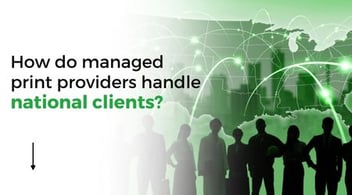6 Challenges Managed Service Providers Face in 2024

Welcome to 2024, a world that needs high-quality IT support more than ever in history.
The managed service provider (MSP) space has changed quite a bit during the past few years. Many businesses have converted their workforce to partial or total work-from-home status.
This exodus from physical offices has forced many businesses to rely on their IT support, which means the demand for good MSPs is higher now than ever.
However, the rapid expansion of the IT market brings new challenges to the table, and even the best MSPs can sometimes struggle to stay ahead of the curve.
Here at Print Partner, we work with hundreds of MSPs across the country to deliver quality print service to your clients.
Through our time working with MSPs, we’ve uncovered the top six challenges they continue to encounter in 2024 and beyond. Using these tips, your business will be armed with everything you need to take on the competition and overcome your biggest industry hurdles.
1. Finding and Retaining MSP Staff
The foundation of any great business, MSP or otherwise, is finding and retaining talented employees. Fantastic employees should ideally bring both top talent and excellent customer service—forged through experience—to their respective roles.
While this is generally true for most ventures, it’s especially crucial for MSPs.
The interactions your employees have with your clients are an integral aspect of the outsourced service experience you provide. Depending on that experience, your clients will be ready to renew immediately upon their contract’s conclusion or may be looking for a new partner, months in advance.
4 things for MSPs to consider for recruiting and retaining top talent are:
-
Maintaining a strong, supportive company culture through communication (source: TechTarget)
-
Creating opportunities for new hires to thrive, based on their inclinations
-
Training new hires thoroughly before thrusting them into critical positions
-
Interviewing off-boarding employees to mitigate issues that made them leave
Let’s take a closer look at that first one, which is arguably the most important.
Build a Killer Company Culture
Alongside the expertise required for the role, your recruitment program should also prioritize values like communication and personability. Over time, these values become cornerstones of your company culture, benefiting all new and existing employees—and thus driving retention.
People respond well to recognition and being rewarded or their efforts. Creating a supportive environment where people are incentivized to excel will help foster additional buy-in.
Of course, you’ll also need to keep compensation and benefits competitive to best ensure your most valuable employees’ long-term team membership. A killer company culture will help your recruiting team attract top talent and ensure they remain contributors in perpetuity.
2. Securing Your Technology Stack
Businesses partner with MSPs for peace of mind—the comfort that your outsourced services will seamlessly relieve operational pain points for your clients (e.g., insufficient bandwidth).
However, the security of your own technology stack is a crucial element of that as well.
Ensuring that security is not easy—one 2021 study from Imprivata found that over half of businesses surveyed were impacted by a data breach due to a third-party vulnerability. If businesses partner with you for quality and delivery assurance, a poor cybersecurity record will introduce doubts about your capability and reliability.
Because MSPs commonly utilize multi-tenancy and network connections with their clients, any cybersecurity vulnerability or breach that affects you also could impact all of them.
To prevent these vulnerabilities, you’ll need cybersecurity protections beyond the basics:
-
Encryption and safe storage for client data
-
Robust remote access security (e.g., multi-factor authentication
-
Advanced tools like endpoint protection IoT devices, such as printers
Cybersecurity threats increase in sophistication every year. Reputational damage from an unsecured technology stack can quickly become unrecoverable for an MSP.
Your technology stack’s cybersecurity is a top challenge every year—and one you should prioritize addressing.
3. Managing Supply Chain Shortages and Planning in Advance
In the wake of the pandemic, supply chain shortages remain one of the most common and impactful challenges affecting the entire economy. MSPs and their clients aren’t immune; TechRepublic finds that over 90% of MSPs—and their clients, by extension—have felt the impacts of supply chain issues.
Optimizing visibility across your hardware is the easiest way to begin managing supply chain issues more effectively. Extending hardware lifecycles allows you to spread out and diminish the impact of individual delays.
To get ahead of potential supply chain issues, you should consider:
-
Using virtualized desktops on old computers, salvaging utility from obsolete hardware
-
Migrating to cloud solutions to minimize hardware overhead for servers and storage
-
Adopting a forward-looking procurement strategy, ordering essentials well in advance
By extending hardware lifecycles and ordering necessities earlier, you can better insulate your clients from supply chain challenges.
First, you’ll need to project the optimal period to balance prices and procurement timelines. Then, you can provide the materials and data for your clients to make informed decisions, helping them feel that you always have their best interests in mind.
Better hardware planning leads to client retention and long-term revenue stability.
Advanced Service Delivery Planning
Beyond a forward-looking procurement strategy, MSPs must be mindful of how they schedule service delivery. Advanced service delivery planning provides two massive advantages:
-
Your clients will appreciate the notice and can better prepare, preventing potential delays that extend timelines, disrupt their workflows, and increase total costs.
-
You can better organize and allocate the right personnel and resources to ensure quality and efficiency, opening up greater bandwidth to service new and existing clientele.
These benefits are especially impactful for larger-scale projects like system implementations and first-time configuration setups. Scheduling in advance can provide a buffer against instability.
4. Managing Third-Party Service Providers
MSPs also leverage the advantages of outsourcing with their own third-party service providers, either for their internal needs or to augment their existing client offerings.
Specialization generally leads to greater success and more value.
MSPs can improve client conversion and retention by partnering with other specialized service providers, expanding their portfolios more effectively than further taxing existing personnel.
You can reduce costs, reclaim bandwidth, and augment your offerings by outsourcing some combination of the following services, depending on your needs:
-
Security operations center (SOC) responsibilities
-
Hardware sourcing (e.g., CDW)
-
Software- and Platform-as-a-Service (SaaS and PaaS) providers (e.g., Pax8)
-
Spam filtering and employee training (e.g., KnowB4)
If your revenue margins aren't sufficient compared to the bandwidth loss to offer print services to the clients requesting them, you won't want to lose the client to another MSP that does.
So, you can partner with a specialty printing services provider—like Print Partner—to expand your portfolio without compromising your ability to execute higher-priority offerings.
To learn about the differences in managing print in-house or working with a third-party provider, read: MSPs: Managing Print In-House vs Through a 3rd Party.
5. Streamline Professional Services Automation for Optimal Workflow
Professional services automation (PSA) platforms are the core of any effective MSP.
PSAs aggregate the most critical enterprise resource planning functionally for an MSP to track their current and future activity, identify clients with the best lifetime value and discover new ways to increase value and better client relationships. Your PSA should unify and optimize:
-
Customer relationship management (CRM)
-
Service desk and ticketing
-
Project tracking and resource planning (e.g., advanced scheduling, billable hours, SLAs)
With these systems and their data integrated under one PSA, you can more easily pull reports for internal and client metrics, further optimizing workflows. Consider meeting with team leaders on how to refine your processes, and have them do the same with their teams.
However, you should always remain open to “boots-on-the-ground” feedback to understand your frontline employees’ day-to-day challenges. Direct communication provides greater insight and makes employees feel supported—reinforcing the killer company culture you’ve created.
Consulting your PSA for individual team members’ impact will better inform you on who your top performers are, as well as what situations personnel struggle or thrive within—a win-win.
6. Pricing Technology Stack and Maximizing Profit
Managing challenges two through five will eventually lead you to evaluate your technology stack pricing. Doing so is a challenge in its own right, comprising the following considerations:
-
Carefully selecting the most secure platforms, services, and other IT resources to help establish a stable overhead for your service delivery costs.
-
Effectively managing your and your customer's supply chain with advanced planning to help keep those costs lower.
-
Considering which third-party service providers add the most value to help expand your portfolio and revenue stream with minimal added costs.
-
Evaluating reports pulled from your PSA and ERP systems to show which offerings are causing the most implementation and ongoing management issues.
With this information, you can continually optimize your technology stack for the most seamless delivery, management, and operation—and maximized profit. Highlight the best tools for each specific need to ensure their hardware and technology stack are optimally suited. You may want to offer your technology stack to clients without adjustment to prevent decision-makers from being bogged down or future service fulfillment issues, since you’ll likely be managing them.
Expanding MSP Portfolio with Print Partner
Printing services are some of the most challenging for an MSP to add to their portfolio, and most simply don't want to increase their service delivery management demands. But many companies need printing services, and MSPs risk losing clients if they don't offer them.
That’s where Print Partner comes in.
At Print Partner, we collaborate with MSPs and client networks seeking print services to fill that need, without trying to gradually assume all service delivery through a matching portfolio. We handle the printing so clients can focus on delivering—and expanding—their service offerings.
So consider partnering with us, a Print Partner you can trust.



